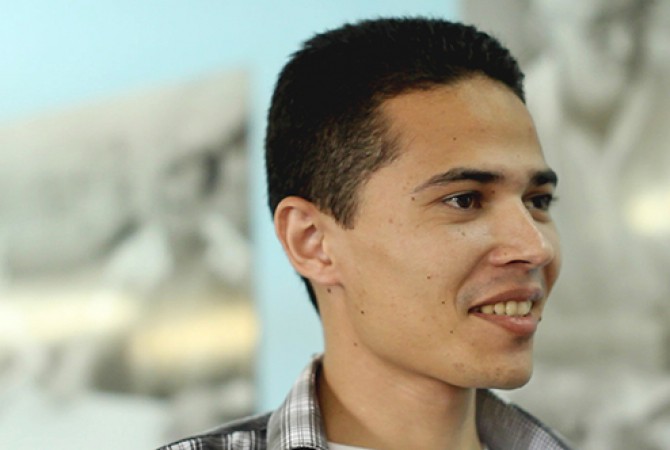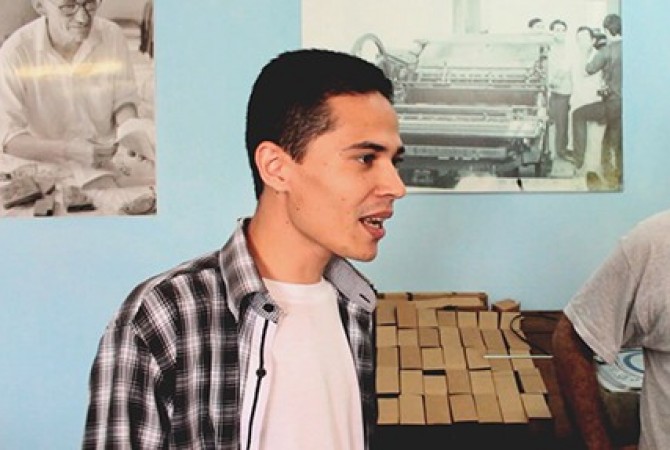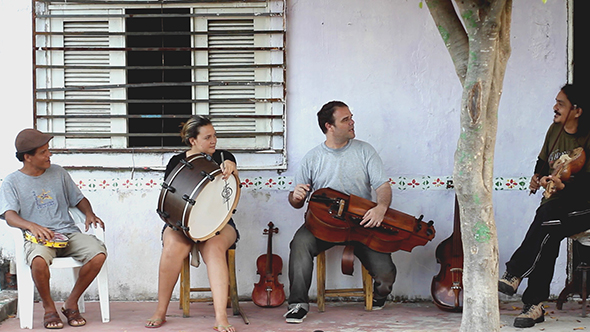
Francisco de Freitas, Pablo Lerner and others musicians, 15/05/2014. Photo: Daniel Leão
From Phenomenology of the Encounter to Transnarration
Leonardo Guelman and Nuno Sacramento
In 1900, only 10% of humanity lived in cities. By 2007, this number had already risen to 50%. The prediction is that in 2050, 75% of the world population will live in urban centers. The next 150 years will see social changes never seen in previous centuries, changes that can already be witnessed on a global level. What will this mean to our experience of territory, to our perception of space, the planet, of the other?
In mid 2014, a group of artists, curators and academics living in the states of Rio de Janeiro, Paraíba, and Ceará and myself, a Portuguese curator living in Scotland, came together in Brazil’s northeasthern region of Cariri, Sertão (literally hinterland/rural regions of the northeast) in the cities of Juazeiro do Norte and Crato and surrounding areas. The idea was to observe the various forms of culture produced in Cariri, discuss questions of art and artisanship and publicness and explore possible interconnections between regions, contexts and practices. The big difference between the articulation of these forms in 2014, and let’s say in 1900, is that the presence of the Internet nowadays creates a contamination that substitutes for the anthropological gaze of the turn of the 19th century to the 20th.
More than the contamination of the images and ideas of the Internet is the physical presence of the Sertão in Rio through its emigrants. On the day we returned to Rio in the taxi, we realized that the driver had family connections in Juazeiro do Norte. On my arrival at the Bed & Breakfast where I was staying, the porter’s face said the same, this all in the space of an hour. From there on out, I was treated differently, as someone who knows the Sertão, as a kind of insider. The presence of the Sertão in the city through its people, in culture through literature (From the poetic traditions of Cordel to Suassuna) and through the music of Carnival, was for me a discovery of great significance.
This only confirmed an intuition I had previously, that the culture of the Sertão and the city should not be seen from the perspective of the dichotomies of inside and outside, center and periphery or urban and the rural, but rather as a absolute continuum, as mutually contagious things.
As part of the group that went to Cariri, Leonardo Guelman and I were invited to write a text about our trip. Guelman is well-traveled and a great expert on all things of the Sertão. I am Portuguese, living in Scotland and Director of the Scottish Sculpture Workshop, based in a rural village of 300 inhabitants. What unites us is the total disregard for any form of cultural hierarchy. Both of us think that the quality of stories and shared narratives have more value than taxonomical dichotomies of the importance of cultural forms between the urban/rural, traditional/contemporary, and artisanal/ intellectual. We are both passionate for encounters between so-called different forms and for the dialogue between those givens often seen as irreconcilable. Guelman has developed in recent years what he calls the “Phenomenology of the Encounter”, drawing on the more porous, affective, contagious elements of an encounter. When things meet, they change each other, forever. The way we see is transformed through physical contact, smell, and as a consequence our thinking also changes.
The day I met Guelman, introduced to me by my friend Guilherme Vergara, the first question he asked me was about “that idea” of the Shadow Curator, something that surprised me until I saw a copy of a publication on his desk. I explained that the Shadow Curator1 had its genesis in my Ph.D. thesis (Shadow Curating: A Critical Portfolio) that sought to outline an articulation of a critical perspective in relation to curatorial practice. The metaphor I used was that of the shadow minister, a role common to UK governmental operations. Here, every minister has his shadow minister, one who criticizes and proposes alternatives to those in power. Similarly, I suggested that there be someone to propose constructive criticism and interesting alternatives to the work of a contemporary art curator.
To Guelman, there was, without doubt, an overlap between our research practices, between the “Phenomenology of the Encounter” and the “Shadow Curator”. I also understood these similarities at the time of our meeting, and the form this encounter could take, or how it could be alternately formalized between the two of us.
The writing process of the text that follows was based on these two methodologies and is a testimony to the “encounter” between them. Upon our return to Rio, Guelman dove into his Sertão writings-experiences to offer a poetic reflection on the phenomenology of the encounter and the trip to Cariri. Upon receiving the text, I put myself in the role of the Shadow Curator, questioning aspects of the text, while proposing new readings and relations.
We can say that this performative gesture had not so much to do with the description of the methodologies, but rather with an activation of the same. We hope the reader is challenged to engage with the tension between the two propositions rather than taking a clear and dichotomous position. In Guelman’s words this “thinking-text is a methodology that envisions a book-as-process, as a journey and as travel, that is revealed in the research resulting from a broad cartography of the Sertão, a Sertão that is multiple and indivisible as the world itself”.
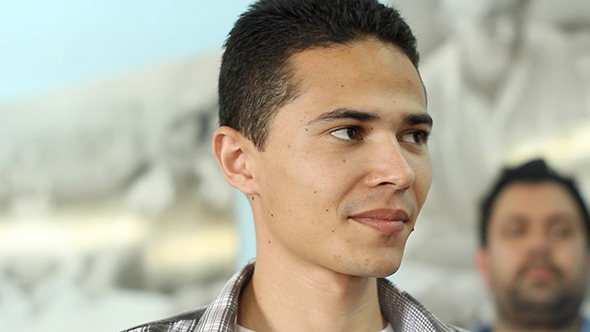
Francisco Bruno Elias da Silva, Cariri, 2014. Photo: Daniel Leão
[Leo] There are entire days that pass unnoticed and others that spring forth filled with small intensities.
The horizon high in the mountains rewarded the difficult ascent on the twisted road. The unfolding of time was now other, the route that followed seemed to touch the heavens. Then, the road disappeared, or at least, I couldn’t seem to recollect it. I remember, before branches sticking out of the tops of the das umbuzeiros (tropical tree) and the sky rushing into the night and the walkers like wandering snails caught by the lights of vehicles crossing. The next day was bright and the colors spread in vignettes transforming that plateau into a huge tapestry. There was no way not to stop at that very moment that was, in fact, to last two hours.
A first phenomenology of the landscape is always a rupture of aesthetic pathos that goes beyond the possibility of a sense of control. He who travels and moves within territories is a collector of appearances, of oddities made from their own discontinuity. In crossing borders and territories, as new regulatory spaces, the traveler can see him/herself, little by little, involved in a new mesh of aesthetic and semiotic references.
We returned to the street and to the game of looking at houses, wandering in all directions, like the man in the crowd overcome by an endless obsession. Crossing small passageways, we reached the street; makeshift tents were everywhere and the marketplace, another clamor, this time more decipherable. Could be a holy day or occasion for a profane party in the ebullience of that little town. Perhaps the tittle-tattle had mentioned something long awaited but what was certain was that some event would give us our first tie of relationships with the place.
[Nuno] 1) I would like to start with a very general question; what criteria makes a thing or place be seen as inside or outside a discourse, a geography or set of priorities? How and what was dealt with on this trip, the idea of inside/outside and center/periphery?
Our challenge here is to begin to bridge the look from a distance, the capture from the outside, to enter into the fabric of encounters as an index of multiple circumstances. We crossed villages, small towns that led us to other periods of in-between spaces, until we converged at a point of interest: a place that had been barely sketched for us, or rather only existed as a name, as an emblem.
Without control of the process, the route shows itself as the right path and each point attracts us, caught between going and hesitating until one chooses a provisional center that is the point from which we begin again. From here we establish a milestone that is, above all, the opening up of a time or the registering of (our) time-detour over time-capture in the flow of routines.
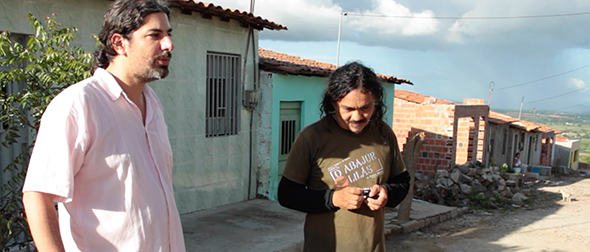
Felipe Caixeta and Francisco de Freitas. Cariri, 2014. Photo: Daniel Leão
The eye takes in the panorama of that small town’s signs; the gaze of the foreigner, looking round, converts the visitor into a sort of inspector of minimal scenes: flower beds, arrangements of colorful balloons, old Chevrolets, unusual houses, the delicate lacing of leaves and all this in a tentative exploration that hesitates between any synthesis or possible syntax. Immersed in this movement, the visitor-inspector just drifts in a time-play, then, discovers in that disposition of self the precondition that enables an encounter. Aware of his castaway condition, he bets on the future of 15 to 30 minutes more. In other times it didn’t happen in this way: when as a kind of describer of sequential scenes, limits to other forms of knowing were not transposed; the world was taken in from a moving window, but without bringing forth the time-experience of other perceptions. Now one began to grasp the time of duration, the slow time that doesn’t allow itself to be seen from the outside, the time of becoming a lizard just taking in the sun and another time-window is opened up to understanding. It is in this time registered in space that one looks to mend one’s fabric, laying the groundwork for its “order” of connections and detours.
We are now in the instance of the place, with its own movement(s), its shared historicity and its continuous arrangement of affections, and it will be in this complex set of references that we will seek a deep immersion. The pathos of the encounter and its aesthetic ecstasy moves from the background of the landscape to the contexts of proximity: a dry river, a cemetery, a large open field that leads to cobbled streets, children with simple clothes, the colors and the language of the houses, the kind of
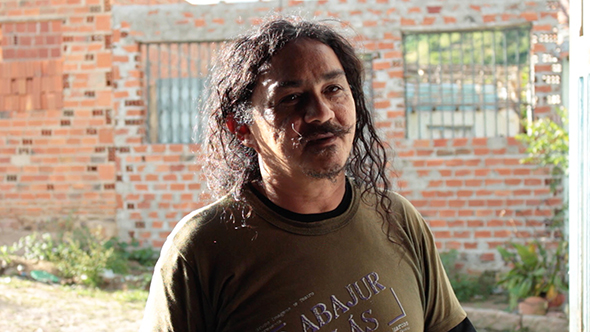
Francisco de Freitas, Cariri, 2014. Photo: Daniel Leão
thing that creates the image of a place and an apparent “common” to any village.
Searching for unique encounters is in many ways a conformation of the place that speaks: the trees in the large square dress themselves in an impressive sonority as an immense rattle of invisible birds that seemed to intone an indecipherable language, very far from a melodic and harmonious singing. Perhaps it was the profusion and the celebration of an immense spontaneous breeding, but it comes to us as something unknown, as an astonishment that immediately grabs us. It was a great interval; that noise that disrupted and dazzled.

Francisco de Freitas, Cariri, 2014. Photo: Daniel Leão
2) You decided to go to the Prophet Gentileza and the Sertão of Cariri to open up to the forms of knowledge that both offer. As an academic and theoretician, you tried to reach out to these places, to understand them deeply, rather than pulling them into the university, submitting them to an academic-scientific logic. Is this move of yours to “the encounter” to what is considered other or outside, what you mean by the phenomenology of the encounter?
Phenomenology assumes a certain order of appearance and projection of meaning that goes beyond the empirical condition of experience. It is a method in process, and also, a description of the forms of appearance and emergence of meaning triggered by a particular trajectory in the world. The encounter, in turn, is not something you anticipate, but the conjunction of unique potencies* that erupt and reconfigure the trail of meaning set forth by traditional forms of research. A phenomenology of the encounter then assumes a way of knowing that is underpinned by experience (that is not merely empirical), having as its expressed condition the fact that we are inscribed and understood in the very space where we comprehend. The textuality of encounters is the very comprehensive way in which the description of the territories is woven, and our process implies an impregnation with these collected experiences.
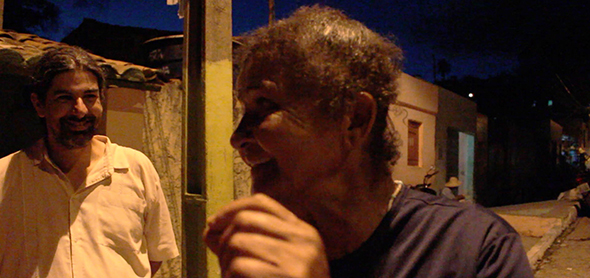
Felipe Caixeta and María do Horto, Cariri, 2014. Photo: Daniel Leão
3) What encounter is this? What are the characteristics of those who encounter and the encounter itself? Will the characterization of this encounter be what you call phenomenology? Can you elaborate?
. . .
4) This idea of the encounter seems to presuppose the overcoming of hierarchy, a going beyond the asymmetrical relationship between different geographies, forms of knowledge and identities. How and what might go beyond assumptions of center/periphery, academic/popular, urban/rural, artistic/scientific? Are affection, empathy and the communion of the sensibilities ways to overcome these dichotomies?
Places entangle texts and semiotics and also the privilege of their narratives, but what can we understand if we don’t enter into its web of desires and affections and speech?
Engaging with a unique way of seeing or speaking is a form of contagion with the density of the experience of otherness carved on the body – and how it shows its face in close-ups! A phenomenology of the encounter, here, is no longer merely visual or kinesthetic; it is extremely effective. It is an engagement with different ways of being and putting oneself in the middle of the game of the versions and features of a place. But not every encounter carries intensities – a reaching out from oneself toward the other – , because, there are numerous banal situations that become the norm. The intensity is in that which an encounter is capable of forging, and fully immersed in that which emerges in time and the temporality of that experience. The encounter as event can never be reduced to the confirmation of a presupposition or as evidence, but it is something that always exceeds and transforms us.
Territory gains new form within the experience of language. We no longer conceive of place as an instance that circumscribes people, but rather, on the contrary, as something that is constituted and results from the expressed articulation of those living there. Any listening there characterizes a primary communication (affective) – beyond any rational explanation; a listening that is also a seeing and feeling with the other, a disposition (empathy) that situates us in the field of relations of a place and opens ourselves up to its own historicity (woven between the personal and social), its mythologies and daily rituals. To do this means interacting simultaneously in affective experiences, in conversation, in going around about with the other,* in entangling oneself in their own language and their turns of phrase; it is a gradual assimilation of a place, making of this process a consciousness self-inscription.
The stories collected in the experience of the encounter form landscapes that are also shades of living: the tone of language, the density of time; relational spaces are here features that surpass any notion of a primary objectivity of experience. Everything enhances and affects us in this communion of sensibilities. Continued conversation amidst proximity also shows itself as philia, as a processually affective disposition that creates a shift in understanding. And here it shows the processual key to encounters. Chasing time, forcing time or making our phenomenological time converge with other personal times and the very cosmology of a place as experience takes us away from objective exteriority and places us in the shared experience of space time.
In the experience of proximity, the stories and voices collected in affection could not be restricted to a purely informative dimension. Immersed in conversation we are not looking to be informed of anything in the way of an interview. On the other hand, these voices-stories come to dwell within us, mixing with our own experiential density, transiting between other conversations as an increment of a transnarrative condition that also comes to permeate our future writings and speeches. What we heard in the depths of the encounter is not something we left back there, but something that returns to us adding to the expressive power of our story, our writing, which is always a translation and conciliation of multiple experiential elements woven together in the thread of our speech and our recounting. To know, and, in this case, to understand via the strength of the experience of language, opening up to becoming and otherness is always a deep prospecting beyond the apparent surface of places. It is this transiting that leads us to immersion or contagion within the powerful lived fabric of places, and the deep-traveler is taken with a surprising contentment when faced with this other experience. In fact, what occurs as a condition comes to us also by the force of the surprise and the accidents along the way as something that escapes the measure of rationality and achieves (occupies) their own space in the economy of our narrative courses: multiple voices and coextensive meanings re-situate our understanding of places; the behind-the-voices, deep experiences, shades of living, and modes of being that transfer themselves into one’s own manner of telling.
There is, here, a new orientation (compass) to make us turn, as now we are taken with another form of enthusiasm that leads us from one place to another in search of narratives and expressive points of view, of intensities of seeing, finally, of experiences that resituates us, and the wisdom that we recognize in someone is the achievement of a position (assumed by it), of a certain stability that also references us. This form of prospection – the convergence of experiences – ends up being guided by a spontaneous magnetizing field inscribed in the relations of the place. So our itinerary – whatever it is – is organized from some trace or trail that we find, which is always a line connected to others. The experience of these multiple lines punctuated by unique encounters becomes the subject of the description of places, as well as the way we look for them.
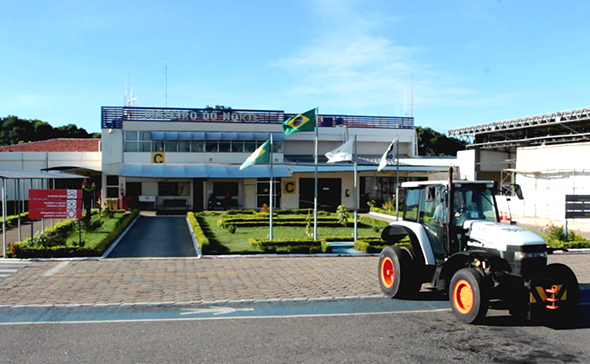
Airport Juazeiro do Norte, Cariri, 2014. Photo: Daniel Leão
5) Above you speak of the unpremeditated encounter, the accidental meeting. You also state that the encounter happens by virtue of unique potencies, and underline the fact that we were inscribed and understood in the very space of comprehension. What do you mean by that? You also speak of the textuality of the encounter and the description of the territory according to the intensity of the experience. What other ways besides the verbal written language can be mobilized for the description of territory? A priori I can think of cartography as a privileged form of relating to territory…
Understanding changes our relational space, our own disposition. Already we can’t travel through a space and not let it affect us. We occupy and fill it, significantly also bringing the impasses and desires that are enwrapped in its continued incompleteness; what does it mean to have as an ethos (position) that it is always the time and the way in which we place ourselves that removes us from indifference? We are “peopled” with these experiences that add to those of other places and the traveler now carries within him or herself the formation of multiple spaces of experiences. We recognize ourselves, also, not just as collectors of appearances (sudden aesthetic effects), but of experiences and ways of being that make us dwell between words and images, echoes of the concreteness and transparency of places that make up our kaleidoscope of references.
6) Tell me a little about your idea of transnarration. Is this a kind of ethnography of the encounter, the writing of a new kind of registering, beyond anthropology? What kind of register is this?
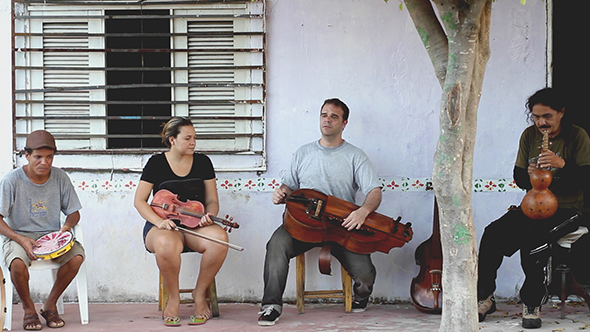
Francisco de Freitas, Pablo Lerner and others musicians, 15/05/2014. Photo: Daniel Leão
The time of (re) writing of the book-as-process brings us to leafing through these snapshots as a phantasmagoria of places. And to all this we add an instrumentation that is essentially expressive, producing itself as part of the paths generated: sketches, drawings, maps, diverse images of embodiment, and more, beyond the sertões, in landscapes (fabrics), portraits (densities), and a kind of imagistic composition of elements produced as constructs (or coisários (T.N. a box of things/also odds and ends) that articulate the amalgamation of expressions with which we work. More broadly, the narratives collated in the book-as-process have transited various means and forms suggesting a bricolage of writing pieced together from unique moments of experience. More specifically, it is understood that this narrative writing should also be expressed as transnarration, by expressive dislocation (already discussed), but also, crucially, by the space of inter-references (and interferences) with other subjects (authors), many of these as enunciators, authorities on these places (special characters from the places), that permeate descriptions and expressive views on the Sertão condition and its various territories. Like this, the process unfolds. We dream and seek the multiplicity and polyphony of sayings in an expressive journey that crosses through places combining with various descriptive tools. In this expressive conjunction the image is not subordinated to the text, nor is this subordinated to that. We could translate this understanding into the formula: text is image, image is text; the image is the other of the text, and the text, the other of the image. This understanding unfolds in all the resources we use such as drawings and maps, all our notes, and cartographies as poetic measures of the Sertão, which extend and come together in the process of the book.
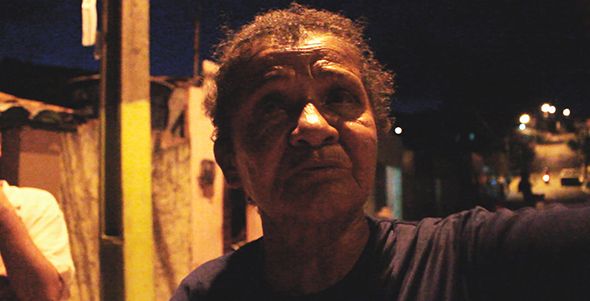
María do Horto, Cariri, 2014. Photo: Daniel Leão
. . .
There is also a tension and impasse inscribed in this very way of working, and this already helps to guide the process as a whole: it concerns the many itineraries undertaken in the book, and the book itself producing its own itinerary; two aspects, or even two concepts that neither coincide nor can be confused, especially because of their intrinsic conditions. This brings us back to that autonomy of the domains’ descriptions because the text that introduces and describes these places has its own migration in writing and its own movement (and direction) that does not reproduce or conform to the itinerary of a geographical route. The coexistence (simultaneous) of the territories also ends up producing attractions and convergences, unusual flows that dislocate and remove the traveler from a linear path. All of this, in some way, also alters the “final” logic of the path.
Even in treading on the regularity of the territories (they present us, each in turn, a greater descriptive line as condition of legibility), our work reveals itself as extensively processual, as the experience of various times between visits and temporary exile in the Sertão – after all, it’s almost ten years between here and there – as an effective discontinuity (various projects as one) that gains the appearance and form of a single thread that unites them. We cannot lose sight of this achievement under our intricate episteme, in that, all explanatory coherence cannot at all superimpose itself on the original driving force of affection and sense of timelessness – a perambulation in the Sertão in all directions as the desire to outline something of the impossible in all that the Sertão transcends. But in all this, and resisting this tension, our work results as this great cartographic sketch, not ended, but provisional, full of existential and aesthetic contours.
In short, our adventure resulted in a fabric woven by these experiences, creating multiple aesthetics, laying the groundwork for an understanding of narrative singularities as an expression of territories and places. Each fabric of this practice of weaving has its processuality, and it is beautiful to see our work emerging from this artisanship of recounted experiences: a woven textured book of this experience-Sertão.
. . .
Ah, not to forget: all art of immersion produced in this way is also a solemn pronouncement: to hell with all and any pure intellectual detachment!
Onward…

Cariri, 2014. Photo: Daniel Leão
_
1 See Nuno Sacramento and Claudia Zeiske, Artocracy. Art, InformalSpace and Social Consequence. A Curatorial Handbook in Collaborative Practice. (Berlin: Jovis, 2010).




